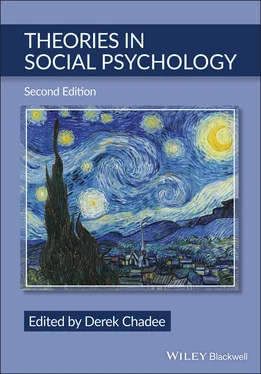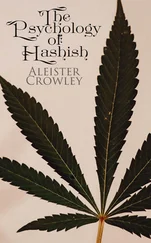Theories in Social Psychology
Здесь есть возможность читать онлайн «Theories in Social Psychology» — ознакомительный отрывок электронной книги совершенно бесплатно, а после прочтения отрывка купить полную версию. В некоторых случаях можно слушать аудио, скачать через торрент в формате fb2 и присутствует краткое содержание. Жанр: unrecognised, на английском языке. Описание произведения, (предисловие) а так же отзывы посетителей доступны на портале библиотеки ЛибКат.
- Название:Theories in Social Psychology
- Автор:
- Жанр:
- Год:неизвестен
- ISBN:нет данных
- Рейтинг книги:5 / 5. Голосов: 1
-
Избранное:Добавить в избранное
- Отзывы:
-
Ваша оценка:
- 100
- 1
- 2
- 3
- 4
- 5
Theories in Social Psychology: краткое содержание, описание и аннотация
Предлагаем к чтению аннотацию, описание, краткое содержание или предисловие (зависит от того, что написал сам автор книги «Theories in Social Psychology»). Если вы не нашли необходимую информацию о книге — напишите в комментариях, мы постараемся отыскать её.
—Robert J. Sternberg,
—Phillip G. Zimbardo, Ph.D., Theories in Social Psychology
Theories in Social Psychology, Second Edition,
Theories in Social Psychology — читать онлайн ознакомительный отрывок
Ниже представлен текст книги, разбитый по страницам. Система сохранения места последней прочитанной страницы, позволяет с удобством читать онлайн бесплатно книгу «Theories in Social Psychology», без необходимости каждый раз заново искать на чём Вы остановились. Поставьте закладку, и сможете в любой момент перейти на страницу, на которой закончили чтение.
Интервал:
Закладка:
There are many definitions of a theory including the following: “A theory consists of an interlocking set of hypotheses that are logically related ,and it seeks to explain the inter-relations among empirical generalizations.” (Tripodi et al., 1969, p. 10). “A theory tries to make sense out of the observable world by ordering the relationships among elements that constitute the theorist’s focus of attention in the real world.” (Dubin, 1978, p. 26). “Theory is a coherent description, explanation, and representation of observed or experienced phenomena.” (Gioia & Pitre,1990, p. 585). “Theory building is the process or recurring cycle by which coherent descriptions, explanations, and representations of observed or experienced phenomena are generated, verified, and refined.” (Lynham, 2000a, p. 8). These definitions all agree on the abstract nature of theories and their attempt to understand and explain.
The recent social psychological literature has been lacking a volume systematically dedicated to a range of theories within the discipline. The emphasis of this second edition, therefore, is on social psychological theories, with an evaluation of some of the main theories still discussed and relevant to understanding behavior. The volume is divided into four parts. Part I presents critical assessments of social cognitive theories – from genesis to their current development.
Derek Chadee and Mary Chadee revisit Brehm’s theory of psychological reactance, identifying the genesis of this theory in the womb of cognitive dissonance theory. However, the baby grew with many different characteristics from the mother. Both theories of cognitive dissonance and psychological reactance are theories of motivational arousal and reduction. The theory of psychological reactance, however, attempts to explain people’s reactions to perceived or actual threat to loss of freedom. The theory builds on several assumptions of human behavior, with a major underlying assumption of human persistence in maintaining free behaviors and the consequences that arise as a result of threats to importantly defined free behaviors. The early emphasis of reactance theorizing and research was on psychological reactance as being aroused by the situation. However, later studies have given emphasis to reactance as dispositional – a reactant personality. Numerous instruments have been designed to measure reactance as a disposition. The merit and demerits of these measures are discussed.
This chapter critically assesses the relationship between reactance and dissonance, proposing reactance as a special case of dissonance though identifying the distinctness of reactance. Critical to this chapter is the identification of the systematic void in the literature of any discussion on affect states in psychological reactance. The last part of the chapter evaluates the relationship between affect and reactance, proposing propositions towards an Affect Arousal Reactance Theory as an addition to Brehm’s Reactance Theory. The chapter concludes by noting that reactance theory is an important theory in the discipline of social psychology and has contributed to an understanding of reactance behavior to actual or perceived threats in a wide variety of settings. The theory is as useful today as it was over fifty years ago. However, the theory needs modification with special consideration to affect as a moderator of reactance. Cindy Harmon-Jones, Paul Nail, and Kurt Boniecki critically assess Festinger’s (1957) cognitive dissonance, from dissonance theory’s inception and rise to prominence in the 1950s, 1960s, and 1970s, to its near-death by the early 1980s, to its rebirth in the 1990s and 2000s. The original statement of the theory was stunning in its simplicity – that an unpleasant psychological state called cognitive dissonance exists whenever one important thought is in conflict with another. Yet this very simplicity was a major factor that has led to a large number of academic debates and controversies over the years. Harmon-Jones, Nail, and Boniecki describe how the germ of the theory got started when Festinger read of the events surrounding a massive earthquake in India in 1934.
They review Festinger’s major theoretical constructs and how these gave rise, early on, to a series of counterintuitive predictions that were generally supported by empirical evidence. Most famous is the finding of Festinger and Carlsmith (1959) that research participants reported a greater liking for boring laboratory tasks if they were paid $1 as opposed to $20 for performing them. Harmon- Jones, Nail, and Boniecki summarize major paradigms that were created to test dissonance theory, followed by rival theoretical accounts, such as Bem’s (1967) self-perception theory. The success of these accounts eventually caused interest in the theory to wane, but more recently has led to a flurry of empirical interest in dissonance and related phenomena, reviewed by Harmon-Jones, Nail, and Boniecki, which persists to the present day. One major focus of the chapter is the “self” theories of dissonance (e.g., Aronson, 1968, 2007; Steele, 1988), which hold that dissonance processes have their origins in the need for self-esteem rather than in a need for logic-like consistency, as originally conceived by Festinger (1957). Another focus is individual differences, e.g., how the different versions of dissonance theory make conflicting predictions for those varying in self-esteem. The chapter evaluates the theory in terms of its applicability, efficiency, heuristic value, and originality, discussing new theorization, including the research of Harmon-Jones et al. (2015) on the action-based model of cognitive dissonance.
Bertram Malle’s chapter examines the history of research on behavior explanations, identifies missing pieces, and introduces a theoretical model that is meant to account for explanations at the conceptual, psychological, and linguistic levels. Heider (1958) was the first to examine systematically how people make sense of each other’s behavior. He introduced the notion of personal causality, ordinary people’s conception of how purposeful behavior works. When a behavior obeys personal causality, it is seen as caused by the agent’s intention, whereas such an intention is absent in behavior that obeys impersonal causality. Thus, Heider captured what was later called intentionality, a core distinction in people’s understanding of human behavior.
Subsequent attribution research turned to different directions. Jones and Davis (1965) shifted from considerations of intention inferences toward considerations of personality and attitude inferences. Kelley (1967) set aside Heider’s distinction between personal and impersonal causality and instead focused on a distinction between person (internal) and situation (external) causes. This internal–external dimension, however, applies only to people’s explanations of unintentional events, not to their explanations of intentional action.
Decades passed before Heider’s original concern with intentionality, and people’s inferences of motives and reasons became a topic of research again. Committed to these concerns, the second part of the chapter introduces the folk-conceptual theory of behavior explanation (Malle, 1999, 2004). It locates explanations in the network of folk concepts people use to make sense of human behavior and specifies the psychological processes and linguistic manifestations of explanations. For example, people offer very different kinds of explanations for intentional and unintentional behavior. Unintentional behavior is explained by causes, which can be classified in a variety of ways, including an internal–external dimension. Intentional behavior, by contrast, is more complex. People offer either reason explanations (i.e., referring to the beliefs and desires in light of which the agent formed an intention to act) or causal history of reason explanations (i.e., referring to factors that led to those reasons in the first place such as upbringing, personality, unconscious mental states). People’s choice between these two explanation modes reflects both cognitive and motivational processes and is sensitive to the explainer’s role (actors vs. observers), the type of agent (group vs. individuals), and the explainer’s impression management goals.
Читать дальшеИнтервал:
Закладка:
Похожие книги на «Theories in Social Psychology»
Представляем Вашему вниманию похожие книги на «Theories in Social Psychology» списком для выбора. Мы отобрали схожую по названию и смыслу литературу в надежде предоставить читателям больше вариантов отыскать новые, интересные, ещё непрочитанные произведения.
Обсуждение, отзывы о книге «Theories in Social Psychology» и просто собственные мнения читателей. Оставьте ваши комментарии, напишите, что Вы думаете о произведении, его смысле или главных героях. Укажите что конкретно понравилось, а что нет, и почему Вы так считаете.












